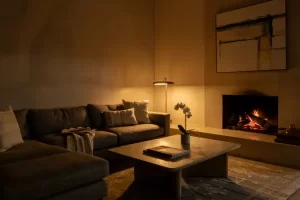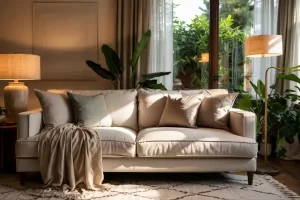When it comes to interior design, ceilings are often overlooked. Most people focus on walls, furniture, and flooring, forgetting that the ceiling—the “fifth wall”—can play a powerful role in shaping a room’s atmosphere. From coffered and tray designs to color choices and innovative lighting, ceilings offer endless opportunities to elevate a space’s aesthetic and functionality.
This article explores the best-kept secrets of ceiling design and how you can use shapes, colors, and lighting to dramatically enhance the visual impact of your home. Whether you’re looking to make a room feel taller, cozier, more elegant, or simply more personalized, mastering ceiling design can be the key to a complete transformation. Let’s look up—and rethink the blank canvas above.
The Importance of Ceiling Design in Modern Interiors
Ceilings are no longer just structural necessities—they’re a key element of modern interior design. A thoughtfully designed ceiling can define the mood of a room, affect acoustics, and even influence how spacious or intimate a space feels. In contemporary homes and apartments, where maximizing every inch is crucial, the ceiling has become a creative surface that invites innovation.
Architects and designers increasingly use ceilings to add depth and character. Whether it’s with bold colors, intricate moldings, or integrated lighting systems, the ceiling can draw the eye upward and make a room feel more cohesive and elevated. It’s a strategic design move that adds both beauty and purpose to your space.
Exploring Different Ceiling Shapes and Structures
Ceilings come in a variety of shapes and structural designs, each offering unique benefits and aesthetic appeal. Choosing the right ceiling shape can dramatically influence the atmosphere of a room. For example, high vaulted ceilings can make a space feel open and grand, while tray or coffered ceilings add elegance and architectural depth.
Flat Ceilings: Timeless and Versatile
The most common type, flat ceilings, are ideal for minimalistic or modern interiors. They provide a blank canvas for creative lighting or decorative molding. When paired with recessed lighting or sleek pendant lamps, flat ceilings enhance clean lines and a contemporary feel.
Vaulted and Cathedral Ceilings: Height and Drama
These ceilings slope upwards, often following the roofline, creating an airy and expansive atmosphere. They’re perfect for large living rooms or open-plan layouts, bringing in natural light and amplifying space. Wood beams or skylights can be added for rustic or luxurious touches.
Tray and Coffered Ceilings: Depth and Sophistication
Tray ceilings feature a central inset, while coffered ceilings consist of a grid of sunken panels. Both styles add architectural interest and a sense of elegance. They’re often used in dining rooms or master bedrooms to draw the eye upward and create a focal point with lighting or contrasting paint.
Using Color to Add Personality and Depth
Color is a powerful tool for transforming ceilings from overlooked surfaces into integral elements of design. Whether you want to create contrast, enhance spatial perception, or express your personal style, color can redefine how the ceiling influences the room’s mood.
White for Brightness and Openness
White remains a popular choice because it reflects light, makes rooms feel more spacious, and blends with nearly any decor style. It’s especially effective in small spaces or rooms with low ceilings, helping to eliminate visual boundaries.
Dark Tones for Drama and Coziness
Painting the ceiling a dark color—like charcoal, navy, or deep green—can create a cozy, intimate atmosphere. When used with high ceilings or balanced with lighter walls and floors, dark tones draw the eye upward and add a touch of drama and sophistication.
Accent Colors and Two-Tone Effects
Ceilings painted in unexpected colors, such as blush pink, pale blue, or soft sage, introduce personality and whimsy. Two-tone combinations—like a ceiling that matches accent walls or contrasts with trim—can create visual harmony and help define different zones in open-concept spaces.
Lighting Techniques That Enhance Ceiling Design
Lighting plays a dual role in ceiling design: it enhances the visual appeal of the ceiling itself and sets the overall mood of the room. Strategic use of light fixtures, placement, and brightness can highlight architectural elements and create a layered, inviting atmosphere.
Recessed Lighting for Minimalist Elegance
Recessed or can lights provide clean, unobtrusive illumination that works well with modern or contemporary ceiling designs. They highlight textures and shapes without competing visually, making them ideal for coffered or tray ceilings.
Pendants and Chandeliers as Focal Points
Suspended lighting like chandeliers or pendant lights brings attention to the center of the ceiling. These fixtures double as functional lighting and design statements, adding elegance, drama, or whimsy depending on the style you choose.
LED Strip Lighting and Cove Lights for Ambience
LED strips or cove lighting installed along ceiling recesses or moldings add soft, indirect light. This technique creates a floating effect and enhances mood lighting, especially in bedrooms or living areas designed for relaxation.
Highlighting Texture with Directional Light
Track lights or adjustable fixtures can be aimed to cast light across textured ceilings. This creates depth and highlights architectural details such as beams, tiles, or patterned finishes, making the ceiling a prominent design element.
Decorating Tips to Make the Most of Your Ceiling
Ceilings often go unnoticed in interior decoration, but with the right approach, they can elevate the entire look of a room. Here are some creative and practical ways to enhance your ceiling decor and make it an integral part of your design scheme.
Incorporate Ceiling Art or Murals
Transform your ceiling into a canvas by adding hand-painted murals, decals, or wallpaper with artistic patterns. This works especially well in dining rooms, nurseries, or reading nooks where you want to add visual interest and personality from above.
Use Architectural Elements as Style Anchors
Wood beams, medallions, or decorative moldings instantly add character and texture to ceilings. These elements create a refined and structured look that complements traditional, rustic, or farmhouse-style interiors.
Experiment with Hanging Decor
In spaces like children’s rooms or eclectic living areas, consider hanging lightweight mobiles, greenery, or sculptural lighting. This adds vertical dimension and brings the ceiling into the decorative mix without cluttering floor space.
Coordinate Ceiling Colors with Wall Accents
For a harmonious design, use ceiling paint that ties in with furniture, rugs, or wall art. This technique creates a cohesive look and allows the ceiling to support the room’s overall aesthetic instead of feeling disconnected.
Reflect Light with Glossy or Lacquer Finishes
Using glossy paints or reflective materials on the ceiling can bounce light around the room, making it feel more open and airy. This is particularly effective in rooms with limited natural light or in compact layouts.
Conclusion: Elevate Your Home by Looking Up
Ceiling design is more than an afterthought—it’s a powerful design element that can transform how a space feels and functions. By thoughtfully combining shapes, colors, textures, lighting, and architectural details, you can turn an overlooked surface into a centerpiece that enhances your entire home.
Whether you’re aiming for dramatic flair with bold ceiling paint or adding subtle elegance through layered lighting and decorative trim, your ceiling offers endless potential. It’s a canvas waiting for creative expression—one that influences not just aesthetics but also ambience, spatial perception, and emotional comfort.
So next time you plan a room refresh, don’t forget to look up. Let your ceiling inspire new ideas and contribute to a home that reflects your personality, style, and attention to detail. With a few intentional choices, your ceiling can rise from unnoticed to unforgettable.




